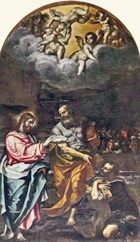A number of Flemish artists visited Italy in the 1560s and 1570s in order to escape the movement against religious imagery that was increasingly influential in their native regions, as study the work of the leading Italian artists. They almost always included a stay in Rome. While they were appreciated as specialists, for example as painters of landscapes, “grotesque ” decoration and glass, they generally found it difficult to secure more mainstream commissions. Two of the artists discussed below were exceptions:
-
✴Arrigo Fiammingo da Malines (Hendrik van den Broeck, 1519-97); and
-
✴Francesco da Castello (Frans van de Kasteele, died 1621).
Others, most of whom soon returned to Flanders, nevertheless left interesting works in Umbria, and particularly in Terni. Those discussed below include:
-
✴Johann Marten Stellaert (died in Rome after 1568);
-
✴Gillis Congnet (died 1599);
-
✴Karel van Mander (1548- 1606); and
-
✴Hendrik de Clerck (died 1630).
Arrigo Fiammingo (1519-97)
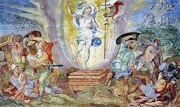
Resurrection of Christ (ca. 1572) by Arrigo Fiammingo
Sistine Chapel, Vatican
Arrigo Fiammingo da Malines (Hendrik van den Broeck, Heinrich Paludanus) came from Mechelen (Malines) in what is now Belgium. He probably travelled to Italy in the 1550s. In his “Life” of Benvenuto Garofalo and others, Giorgio Vasari describes “the Fleming Arrigo” as “a master of glass windows”, and it seems that Arrigo worked in this capacity under Vasari in Palazzo Vecchio, Florence in 1557-8.
Arrigo Fiammingo signed a partnership agreement with Nicolò Circignani, il Pomarancio in Perugia 1564: il Pomarancio took over a commission that Arrigo Fiammingo secured in 1565 for an altarpiece in the Duomo, Orvieto (see below). Both artists worked on the frescoes of the Santuario di Mongiovino at Panicale, near Lake Trasimeno, and Arrigo also worked on the glass there. He received citizenship of Perugia in 1579.
Arrigo was also active on occasions in Rome:
-
✴He signed (“HVDB”) a fresco of the Resurrection of Christ (illustrated above) on the entrances wall of the Sistine Chapel. (The original, by Domenico Ghirlandaio, had been destroyed by the collapse of the papal entrance to the chapel in 1522 and the by subsequent repairs carried out in 1565). Cardinal Jerome Rusticucci probably commissioned the new fresco (and another on the same wall by Matteo da Lecce) in 1572.
-
✴According to Karel van Mander (see below), “Hendrick”, who was probably Arrigo Fiammingo, worked under Giorgio Vasari on the frescoes (1572-3) of the Sala Regia in the Vatican Palace.
Arrigo Fiammingo died in Rome in 1597.
Perugia
Panels
-
✴Christ and St Andrew (1551), on the left, illustrated here; and
-
✴the Martyrdom of St Catherine (1560) on the right.
Adoration of the Magi (1564)
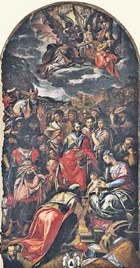
In his “Life” of “Benvenuto Garofalo and others, Giorgio Vasari writes that “the Fleming Arrigo, a master of glass windows, has painted in [San Francesco al Prato] an altarpiece in oils, containing the story of the Magi, which would be beautiful enough if it were not somewhat confused and overloaded with colours, which conflict with one another and destroy all the gradation.
Crucifixion with SS Francis and Herculanus (ca. 1565)
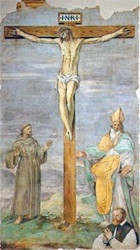
The fresco depicts the Crucifixion set in a landscape, with standing figures of SS Francis and Herculanus to the sides. The praying figure shown half-length on the bottom right is probably Francesco Bossi.
San Bernardino of Siena preaching (1565)

Orvieto
Duomo (1561-5)
In 1561, the Opera del Duomo of Orvieto began negotiations with Arrigo Fiammingo, in an attempt to secure his services in relation to the programme for the decoration of a series of new altars in the nave (see the page on the 16th century remodelling of the Duomo). In 1565, he finally ruled out the possibility of working in Orvieto. Instead, he recommended his associate Nicolò Circignani, il Pomarancio for the frescoes of one of the chapels in question, and he offered to paint its altarpiece in Rome. Nicolò Circignani was duly commissioned to execute the frescoes of the 3rd on the left. He subsequently also painted its altarpiece (1566), which depicted Christ healing a Cripple.
St Jerome (1580)
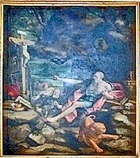
Spoleto
Madonna del Rosario (ca. 1570)
This fresco is San Giacomo was documented in 1625 as the work of “Henrico Fiamengo”, who was almost certainly Arrigo Fiammingo. It depicts the Madonna and Child in glory, with SS Dominic and Francis below. The Madonna hands a rosary to St Dominic, who is surrounded by male members of a confraternity, presumably the Confraternita del Rosario. St Francis is surrounded by a group of ladies, who were presumably their female relatives. St Dominic holds a model of a domed church.
Karel van Mander (1548- 1606)
Karel van Mander, who was born in Meulebeke (in what is now Belgium), trained as an artist in Gand and Tournai. His masterpiece was his “Het Leven der Doorluchtighe Nederlandtsche en Hoogduytsche Schilders” (Lives of the Important Flemish, Dutch and German Painters), which was published in 1604, and which was based on the Lives of the Artists by Giorgio Vasari.
Karel van Mander travelled to Italy in 1573. According to biographical notes in the second (posthumous) edition (1618) of his book, which were probably written by his younger brother, he “occasionally wrote to his parents from [Rome] , where he spent the Holy Year of 1575. Seeing much that was curious, he remained for over three years, practicing his art in one place and another”. He probably returned to his own country in 1578.
Apart from two signed drawings:
-
✴the Flight into Egypt (1576), after Cherubino Alberti, in the Staatliche Kunstsammlungen, Dresden; and
-
✴a putto, after Raphael, in the Rijksprentenkabinet, Leiden,
nothing is known about the work van Mander produced in Italy, except for his frescoes in Terni (below). No other frescoes by van Mander are known.
Terni
Frescoes in Palazzo Spada (1575-6)
The biographical notes mentioned above contain the following information: “First Karel made several large pieces for a count in Terni, a small town in Italy, illustrating the history of the Paris massacre, with the admiral being cast from the window”. These must have been the frescoes in Palazzo Spada, which Count Michelangelo Spada commissioned for his new palace.
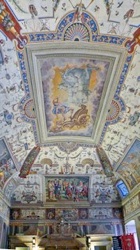

-
✴King Charles IX sanctioning the assassination of the Huguenot leader, Admiral Gaspard de Coligny;
-
✴the wounded admiral being carried home following an unsuccessful attempt on his life; and
-
✴the massacre that followed it (illustrated here), with the wounded admiral being thrown from a window in the background.
These scenes were adapted on a smaller scale from the frescoes (1573) by Giorgio Vasari in the Sala Regia of the Vatican, which were completed very soon after the events depicted in order to celebrate what was seen as a glorious victory for the papacy.

The choice of these scenes, which Vasari had designed for an important public space in the Vatican palace, in order to decorate a residential environment, undoubtedly reflected the anti-Protestant fervour of Michelangelo Spada.
Johann Marten Stellaert (died after 1568) and Gillis Congnet (died 1599)
According to the account by Karel van Mander, Gillis Congnet became a member of the Artists’ Guild in Antwerp in 1561, before travelling to Italy. He visited Naples and Sicily, before going to Terni, where he worked on frescoes with another painter named “Stello”. He worked for Duke Francesco dei Medici in Florence in 1567 and attended a meeting of the Accademia del Disegno there in 1569. He probably returned to Antwerp in 1570. He fled when the Spanish reconquered the Low Countries in 1585, first to Amsterdam and the to Hamburg, where he died.
“Stello” is usually assumed to be the otherwise unknown "I. Mart: Stella. Brabandinus Bruxellensis" (Johann Marten Stellaert of Brussels), who signed an altarpiece (1568) of the Madonna and Child with saints that was documented in the Duomo in 1872 (see below). He was apparently killed by a firework during what was probably the “Girandola” di Castel Sant'Angelo”, a traditional firework display held in Rome on the feast of SS Peter and Paul.
According to van Mander, who (as noted above) had worked in Terni in 1575-6, Gillis Congnet and “Stello” had frescoed a room in one of the city’s palaces with “grotesque ” in the French style. (This was probably a reference to the frescoes and stucco work in the Galerie François I at Fontainbleau, which had been executed by Rosso Fiorentino and associates in the 1530s). The Flemish artists’ work at Terni has been identified as the frescoes (1567-8) of the Salone (now the Sala Stanislao Falchi) in Palazzo Giocosi (see below).
Narni
Frescoes (1570)
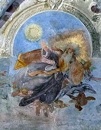
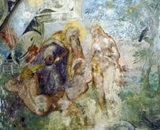
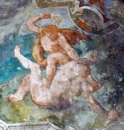
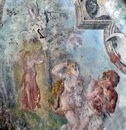
These damaged frescoes, which are attributed to Johann Marten Stellaert and Gillis Congnet, are in the vault of the Cappella del Rosario of San Domenico. The inscription giving the date, which was documented in 1872, is no longer legible. The surviving frescoes depict:
-
✴scenes from Genesis, in the vaults (details of which are illustrated above); and
-
✴the Annunciation, on the right wall.
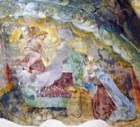
Terni
Frescoes in Palazzo Giocosi (1567-8)
Cinzio and Drusiano Giocosi built Palazzo Giocosi (later Palazzo Giocosi Mariani) in Via Tribunale: it was probably completed by their nephew, Constantino, who is commemorated on the architrave of the entrance to the right. It was restored in 1980-95 and now houses the Istituto Musicale Briccialdi.
The frescoes in Palazzo Giocosi, and particularly those in the Salone (now the Sala Stanislao Falchi) are probably those recorded by Karel van Mander as the work of Gillis Congnet and “Stello” (probably Johann Marten Stellaert) - see above:
-
✴an inscribed date 1567 was found under the fresco of Venus and Adonis in the Sala Stanislao Falchi during a restoration carried out in 2002; and
-
✴the fresco of Moses and Aaron before Pharaoh in what is now Sala Alessandro Casagrande used to have an inscription dated 1568.
Madonna and Child with saints (1568)
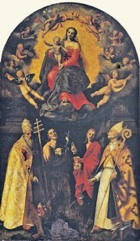
-
✴the Madonna and Child in glory with musical angels; and
-
✴SS Sylvester, John the Baptist, John the Evangelist and Aloysius below.
The altarpiece was documented in the Duomo in 1872 and later moved into storage. It emerged in 1987 and was restored in 2009. It is now in the Museo Diocesano.
Francesco da Castello (died 1621)
Francesco da Castello (Frans van de Kasteele), who came from Brussels, established an important workshop in Rome. He was documented there in 1577, and again in 1587, when Hendrik de Clerck (below) appeared as a witness on his behalf, and he died there in 1621.
Spello
Francesco da Castello signed and dated the panels on the altars at the ends of the aisles of San Lorenzo, which were sent to Spello from Rome:
-
✴Christ and the Virgin receive souls from purgatory (1599)
-
This interesting altarpiece is on the Altare della Madonna del Carmine, at the end of the right aisle. It was probably commissioned by Giulio Diamante, who endowed the altar.
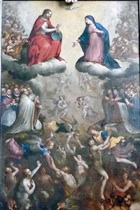
-
-
-
-
-
-
✴Martyrdom of St Catherine of Alexandria (1601)
-
This altarpiece, which was originally on what is now the Altare di San Felice, at the end of the left aisle. Monsignor Girolamo Bevilacqua da Spello, the titular Archbishop of Nazareth, who commissioned the altar, is portrayed in the altarpiece. It was moved to the altar in the 3rd bay on the right wall in the 18th century, to make way for the present altarpiece (see below). However, associated panels by Francesco da Castello that depict three scenes from the life of St Catherine remain in their original locations.
Hendrik de Clerck (died 1630)
Hendrik de Clerck, who probably came from Brussels, was documented in Italy only once: in 1587, he appeared as a witness in Rome on behalf of Frans van de Kasteele (above). He subsequently returned to the Low Countries, where he was appointed as court painter to the Archduke Ernest in Brussels in 1594.
Todi
Deposition (late 16th century)
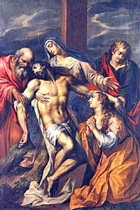
The altarpiece is undocumented and its original location is unknown.











